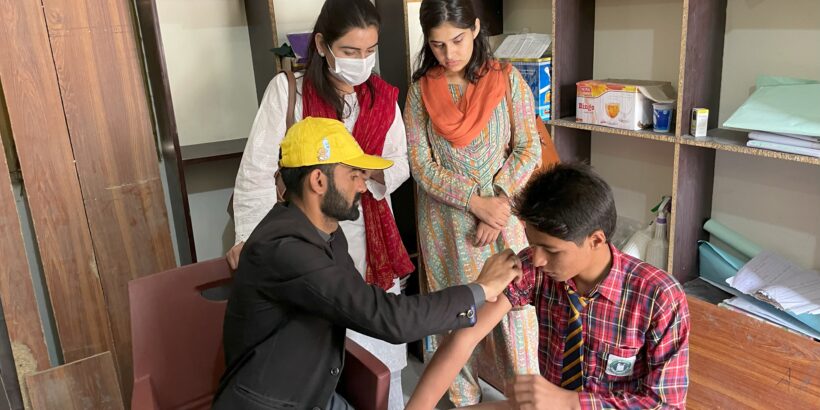Conflicts and disasters drove a record number of people worldwide from their homes in the last year, with 83.4 million living in internal displacement. As of June 2024, there were 122.6 million forcibly displaced people worldwide, 43.7 million of whom were refugees.
These staggering numbers are driven in part by climate change, which is causing an increase in weather related-disasters. When it comes to disease threats, extreme weather and displacement create the perfect storm: flooding and other natural disasters often devastate the systems that provide clean water and appropriately dispose of sanitary waste, putting displaced people at a higher risk of waterborne diseases like typhoid.
As instability forces a growing number of people from their homes, protecting children from disease is critical. Along with strengthening water, sanitation, and hygiene (WASH) infrastructure, typhoid conjugate vaccines (TCVs) can help defend against typhoid before disasters strike.
Extreme weather drives displacement
Disasters and extreme weather are a growing factor behind the millions of displaced people in 2024. Last year, disasters triggered twice as many movements as the annual average during the past decade. Weather-related events, which include hazards such as floods, storms, and droughts, led to 99.5 percent of natural disaster displacements, with cyclones causing 54 percent and floods causing 42 percent. As climate change intensifies, it is exacerbating the frequency and severity of weather-related events, more so than other natural disasters like earthquakes.
The threat of climate change is global, with major flooding events occurring on every continent. The United States recorded 11 million disaster displacements in 2024—the most ever recorded for a single country. In Chad, floods triggered more displacements than the past 15 years combined, while flooding in Assam, India, displaced 2.5 million people. Regardless of geography or income level, all countries are increasingly vulnerable to climate-driven displacement, underscoring the need to invest in resilient WASH infrastructure and other sustainable solutions.
Conflict, violence, and climate change collide
Conflict and violence are the leading forces behind internal displacement, accounting for 90 percent of displacement in 2024. More than three-quarters of people internally displaced by conflict and violence were living in countries with high or very high vulnerability to climate change—meaning that these factors compound upon one another to put displaced people at greater risk of disease.
Many displaced people facing both climate change and conflict also live in countries with fragile health systems and high disease burdens. In the Democratic Republic of the Congo, for instance, floods in the country’s conflict-affected eastern provinces displaced thousands in 2024. Non-state armed groups blockaded roads, which cut off aid to hundreds of thousands of internally displaced people. The combination of conflict and flooding worsened sanitation, spread waterborne diseases, and deepened food insecurity—creating a nexus of extreme risk for affected communities.
Displaced populations often lack access to WASH and essential health care services. Weather-related disasters like floods put further strain on WASH infrastructure and health care systems. In crowded conditions like camps and informal settlements that lack sanitation and safe water, waterborne diseases like typhoid can spread rapidly.
Protecting children in an unpredictable world
While factors like extreme weather and political disruptions are uncertain, disease prevention strategies don’t have to be. We can’t predict when a cyclone will hit or when a conflict will escalate, but vaccines are a reliable investment. TCVs work to prevent typhoid and provide safe, long-lasting protection for children older than 6 months of age.
As rising displacement increases the risk of disease and jeopardizes access to health care, it’s more important than ever that we reach children with TCVs now—because we can’t always predict where a child will be when disaster strikes. Introducing TCVs into routine immunization can provide preemptive protection when extreme weather hits or conflict breaks out.
From climate change, to political unrest, to shifts in global health funding, the world is at an uncertain moment, making it all the more important to stand in solidarity with refugees and displaced people across the globe. On World Refugee Day, we recognize the overlapping crises that many displaced populations are facing and call for greater investment in the solutions that work to prevent disease, like TCVs.
Cover photo: A vaccinator administers TCV during Pakistan’s final TCV introduction campaign in October 2022. The campaign followed unprecedented floods in July 2022 that compromised WASH infrastructure and disrupted access to health services across the country. Credit: PHC Global.



